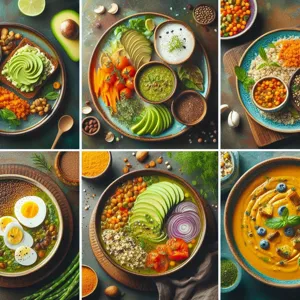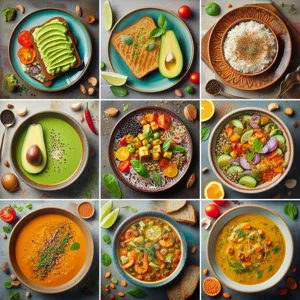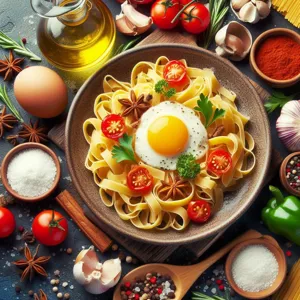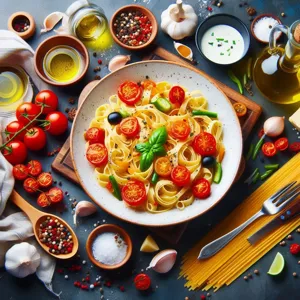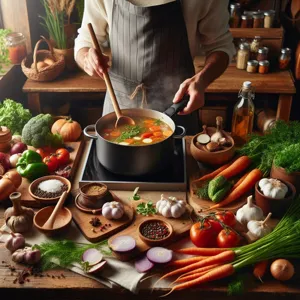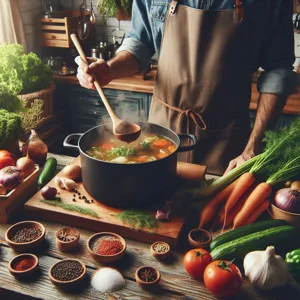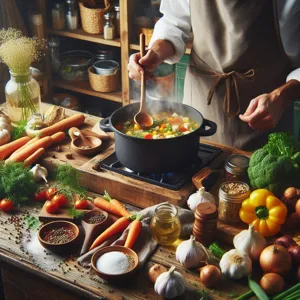In a world where culinary creativity knows no bounds, vegetarian cooking has emerged as an exciting and vibrant avenue for food lovers to explore.
Whether you’re a lifelong vegetarian, a curious omnivore, or simply looking to incorporate more plant-based meals into your diet, this collection of delicious vegetarian recipes is sure to delight your taste buds and inspire your kitchen adventures. From hearty, flavor-packed dishes that make vegetables the star of the show to light and refreshing options perfect for any season, these ten recipes showcase the incredible versatility and richness of vegetarian cuisine. Join us on this mouthwatering journey as we uncover the top ten vegetarian recipes you absolutely need to try today—and discover how satisfying and delicious a meat-free lifestyle can be!
1. Introduction to Vegetarian Cooking

Vegetarian cooking is more than just a dietary choice; it’s a vibrant celebration of flavors, colors, and textures that can transform any meal into a culinary adventure. With the world increasingly embracing plant-based diets for health, environmental, and ethical reasons, vegetarian cooking has become a thriving, innovative field that invites everyone—regardless of dietary preferences—to explore the bountiful possibilities of fruits, vegetables, grains, and legumes.
Imagine walking through a sun-drenched farmers’ market, where the vivid hues of ripe tomatoes, earthy greens, and fragrant herbs beckon you to experiment in your kitchen. Vegetarian cooking invites you to harness the natural flavors found in seasonal produce and turn simple ingredients into extraordinary dishes. It’s about creativity and exploration, mixing and matching spices, and discovering new textures that can tantalize your taste buds.
From hearty stews brimming with nutritious legumes to fresh, crisp salads bursting with seasonal vegetables, vegetarian recipes offer something for everyone. Whether you are a lifelong vegetarian or someone just starting to dabble in plant-based cuisine, you’ll find that cooking without meat can be both satisfying and delicious. With the right recipes in hand, you can craft meals that not only please your palate but also nourish your body and soul.
In this post, we’ll delve into ten delectable vegetarian recipes that are not only easy to prepare but also packed with flavor and nutrition. Each recipe is designed to inspire and excite, showcasing the diversity of vegetarian cooking. So, roll up your sleeves, grab your favorite apron, and get ready to embark on a delightful culinary journey that will have you and your loved ones savoring every bite!
2. Benefits of a Vegetarian Diet
Adopting a vegetarian diet offers a myriad of benefits that extend beyond just health; it encompasses environmental, ethical, and culinary advantages that make it an appealing choice for many.
Firstly, from a health perspective, a vegetarian diet is often associated with a lower risk of chronic diseases. Rich in essential nutrients, vitamins, and fiber, a plant-based diet can lead to improved heart health, lower blood pressure, and reduced cholesterol levels. Studies have shown that those who follow a vegetarian diet tend to have healthier body weights and lower risks of type 2 diabetes. This is largely due to the abundance of fruits, vegetables, whole grains, and legumes that are staples in vegetarian cooking, providing essential nutrients while keeping calorie counts in check.
Moreover, choosing vegetarianism is a powerful way to make a positive impact on the planet. The production of plant-based foods generally requires fewer natural resources and results in lower greenhouse gas emissions compared to meat production. By opting for vegetarian meals, you’re contributing to a more sustainable food system and helping to reduce your carbon footprint, making it a choice that benefits both your body and the environment.
Ethically, adopting a vegetarian lifestyle aligns with a commitment to animal welfare. Many people choose to go vegetarian to avoid the inhumane practices often associated with factory farming. By reducing or eliminating meat from their diets, they take a stand against animal cruelty and support more humane farming practices.
Finally, the culinary world opens up with a vegetarian diet. It encourages creativity and exploration in the kitchen, pushing you to discover new ingredients and flavors you might not have considered before. From hearty lentil stews to vibrant vegetable stir-fries, the possibilities are endless, and you may find that your meals become more colorful and diverse.
In essence, the benefits of a vegetarian diet are multifaceted, enhancing your health, contributing positively to the planet, supporting ethical practices, and expanding your culinary horizons. If you haven’t yet explored this delicious lifestyle, now is the perfect time to dive in!
3. Recipe 1: Hearty Vegetable Stir-Fry
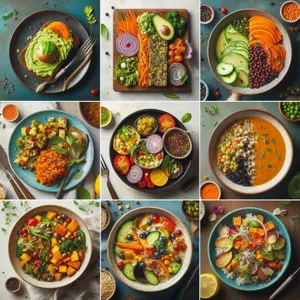
A Hearty Vegetable Stir-Fry is a colorful celebration of flavors and textures that will satisfy both vegetarians and meat-lovers alike. This quick and versatile dish allows you to showcase a vibrant medley of fresh vegetables, all while packing a nutritional punch. Imagine crisp broccoli florets, sweet bell peppers, tender snap peas, and juicy carrots, all sautéed to perfection in a zesty garlic and ginger sauce that awakens your taste buds.
To start, gather your favorite vegetables—feel free to mix and match based on what’s in season or what you have on hand. For the best results, aim for a variety of colors to create a visually appealing dish. The key to achieving that perfect stir-fry is high heat and constant motion; this ensures your veggies remain crunchy while developing a delightful caramelization.
As the vegetables sizzle away, prepare a simple yet flavorful sauce using soy sauce, sesame oil, and a splash of rice vinegar. You can also add a pinch of red pepper flakes for some heat or a drizzle of honey for a touch of sweetness. Once your vegetables are nearly cooked, toss in the sauce and let it coat every morsel, allowing the flavors to meld beautifully.
Serve your Hearty Vegetable Stir-Fry over a bed of fluffy jasmine rice or quinoa to soak up all that delicious sauce. Top it off with a sprinkle of sesame seeds and freshly chopped scallions for an extra layer of flavor and crunch. This dish not only nourishes the body but also delights the senses, making it an ideal choice for a quick weeknight dinner or a vibrant dish to impress guests. With its endless variations and fulfilling nature, you’ll find yourself making this stir-fry again and again. So grab your wok and get ready to stir up some culinary magic!
4. Recipe 2: Creamy Spinach and Ricotta Stuffed Shells
Creamy Spinach and Ricotta Stuffed Shells are the epitome of comfort food, combining velvety textures with vibrant flavors that will leave you craving more. This dish features large pasta shells generously filled with a rich mixture of creamy ricotta, fresh spinach, and a hint of nutmeg, all enveloped in a luscious marinara sauce.
To begin, cook the pasta shells until al dente, ensuring they maintain their shape for stuffing. While the shells are boiling, sauté fresh spinach until wilted, then mix it with ricotta cheese, grated Parmesan, garlic, and a sprinkle of salt and pepper. This filling is not only delicious but also packed with nutrients, making it a wholesome choice for any meal.
Once the shells are filled, arrange them in a baking dish, generously slathering them with your favorite marinara sauce. For an extra touch of indulgence, sprinkle a layer of mozzarella cheese on top before placing the dish in the oven. As it bakes, the cheese melts into a gooey, golden layer, harmonizing perfectly with the savory flavors of the filling.
After about 30 minutes in the oven, the aroma wafting through your kitchen will be irresistible. Serve these stuffed shells with a side of garlic bread and a fresh salad, and you have a complete meal that’s sure to impress both vegetarians and meat-lovers alike. Each bite offers a delightful combination of creamy, cheesy goodness and the earthy taste of spinach, making this dish a must-try for anyone looking to elevate their vegetarian repertoire. Enjoy the comfort of home-cooked goodness with every stuffed shell!
5. Recipe 3: Quinoa and Black Bean Salad
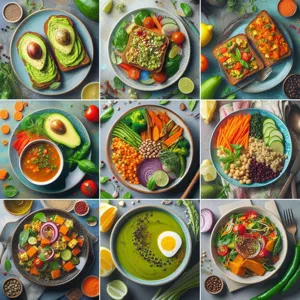
Quinoa and black Bean Salad is a vibrant dish that not only tantalizes the taste buds but also nourishes the body. This recipe showcases the versatility of quinoa—an ancient grain packed with protein and essential amino acids—paired harmoniously with hearty black beans, rich in fiber.
To start, rinse one cup of quinoa under cold water to remove its natural coating, known as saponin, which can impart a bitter flavor. Cook the quinoa in two cups of vegetable broth for a deeper taste, bringing it to a boil and then simmering until the grains are fluffy and translucent. While the quinoa cools, prepare the other ingredients: drain and rinse a can of black beans, chop a colorful medley of bell peppers, red onion, and fresh cilantro, and dice a ripe avocado for creaminess.
In a large bowl, combine the cooled quinoa and black beans, then fold in the chopped vegetables and avocado. For the dressing, whisk together fresh lime juice, olive oil, cumin, salt, and a pinch of cayenne pepper for a hint of heat. Drizzle this zesty mixture over the salad, tossing gently to ensure every bite is coated in flavor.
Serve this salad as a refreshing side dish or a satisfying main course. It’s perfect for meal prep, as the flavors deepen and meld beautifully when allowed to sit for a few hours in the fridge. Not only is this Quinoa and Black Bean Salad a feast for the eyes with its colorful display, but it also delivers a delightful crunch and a burst of flavors that will have you reaching for seconds. Enjoy this nutritious dish as part of your quest for delicious vegetarian recipes that will leave you feeling full and satisfied!
6. Recipe 4: Roasted Cauliflower Tacos
### 6. Recipe 4: Roasted Cauliflower Tacos
Prepare to embark on a flavor-packed journey with these Roasted Cauliflower Tacos! This dish transforms humble cauliflower into a smoky, savory delight that is sure to become a staple in your kitchen. The key to these tacos lies in the roasting process, which caramelizes the natural sugars in the cauliflower, enhancing its flavor and giving it a wonderful texture.
**Ingredients:**
– 1 medium head of cauliflower, cut into florets
– 2 tablespoons olive oil
– 1 teaspoon smoked paprika
– 1 teaspoon ground cumin
– Salt and pepper, to taste
– Corn or flour tortillas
– Fresh cilantro, for garnish
– Avocado slices, for serving
– Lime wedges, for that zesty finish
**Instructions:**
1. **Preheat the Oven:** Start by preheating your oven to 425°F (220°C). This high heat will help the cauliflower roast to perfection.
2. **Prepare the Cauliflower:** In a large bowl, toss the cauliflower florets with olive oil, smoked paprika, cumin, salt, and pepper until well-coated. The spices will add depth, while the olive oil ensures a crispy exterior.
3. **Roast:** Spread the seasoned cauliflower evenly on a baking sheet lined with parchment paper. Roast for about 25-30 minutes, flipping halfway through, until the edges are golden and crispy.
4. **Assemble the Tacos:** While the cauliflower is roasting, warm the tortillas in a skillet or directly over a flame for a few seconds on each side. Once the cauliflower is out of the oven, it’s time to build your tacos! Layer the roasted cauliflower on each tortilla, then top with fresh avocado slices and a sprinkle of cilantro.
5. **Finish with Lime:** A squeeze of fresh lime juice will elevate the flavors and add a bright contrast to the smoky cauliflower.
These Roasted Cauliflower Tacos are not only visually appealing with their vibrant colors but also packed with nutrients and flavor. Each bite is a delightful combination of crunchy, creamy, and zesty elements that make them irresistible. Perfect for a quick weeknight dinner or a weekend gathering with friends, they are sure to impress even the most devoted carnivores. Enjoy these tacos with a side of your favorite salsa or a refreshing slaw for an extra crunch!
7. Recipe 5: Chickpea Curry with Coconut Milk
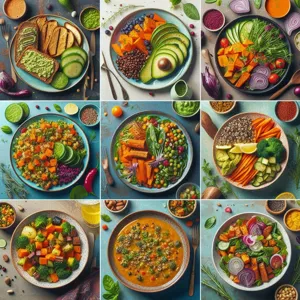
Chickpea Curry with Coconut Milk is a delightful fusion of flavors that transports you to the heart of Indian cuisine with every bite. This comforting dish is not only quick and easy to prepare but also packed with nutrients, making it a perfect choice for both seasoned vegetarians and newcomers alike.
To start, gather your ingredients: canned chickpeas, creamy coconut milk, ripe tomatoes, onion, garlic, ginger, and a medley of spices, including cumin, coriander, turmeric, and garam masala. The chickpeas serve as the protein-packed base, while the coconut milk adds a luscious creaminess that perfectly balances the spices.
Begin by sautéing finely chopped onions, garlic, and ginger in a splash of oil until they become fragrant and golden. As the aroma envelops your kitchen, add in the spices to toast them lightly, releasing their essential oils and deepening their flavors. Next, stir in the tomatoes, allowing them to simmer until they soften and meld into a rich sauce.
Once the tomato mixture is bubbling happily, toss in the chickpeas and pour in the coconut milk. This is where the magic happens; the chickpeas absorb the coconut’s sweetness while the spices create a harmonious blend. Let the curry simmer gently, allowing all the ingredients to unite, and then finish it off with a sprinkle of fresh cilantro for a burst of freshness.
Serve your Chickpea Curry with Coconut Milk over a bed of fluffy basmati rice or alongside warm naan bread for the ultimate comfort meal. The combination of creamy coconut, hearty chickpeas, and aromatic spices will leave your taste buds dancing and your stomach satisfied. It’s not just a dish; it’s an experience that showcases the vibrant flavors of vegetarian cooking. Try it today, and you’ll find yourself reaching for seconds!
8. Recipe 6: Zucchini Noodles with Pesto
### Recipe 6: Zucchini Noodles with Pesto
If you’re looking for a fresh and vibrant dish that bursts with flavor, look no further than Zucchini Noodles with Pesto. This delightful recipe is not only a feast for the eyes but also a celebration of health and taste, making it a perfect addition to your vegetarian repertoire.
To start, spiralize your zucchini into beautiful, long noodles—think of them as a lighter, gluten-free alternative to traditional pasta. The key is to choose firm, fresh zucchinis that yield perfectly tender noodles without becoming mushy. You can use a spiralizer, a julienne peeler, or even a box grater to achieve your desired thickness. The vibrant green strands will instantly brighten your plate.
Next, it’s all about the pesto. You can whip up a homemade version using fresh basil, garlic, pine nuts, Parmesan cheese, and a good drizzle of extra virgin olive oil. Blend these ingredients until you reach a creamy consistency, adjusting with more olive oil or a splash of lemon juice for brightness, if needed. If you’re short on time, store-bought pesto works just as well—just make sure to choose a high-quality option to ensure maximum flavor.
Toss the zucchini noodles in the luscious pesto sauce until every strand is coated in that aromatic herbal goodness. For an added crunch and flavor, consider sprinkling some toasted pine nuts or walnuts on top, along with a few halved cherry tomatoes for a pop of color and sweetness. A sprinkle of grated Parmesan or nutritional yeast can enhance the umami factor, making this dish even more irresistible.
Serve your Zucchini Noodles with Pesto warm or chilled, depending on your preference. This dish is not only quick to prepare but also versatile—feel free to customize it with additional veggies like bell peppers, spinach, or even roasted chickpeas for added protein. Not only is it a delightful meal to enjoy, but it also embodies the essence of summer with its fresh ingredients and bright flavors.
This recipe is perfect for a light lunch, a quick dinner, or even a picnic in the park. Once you try these Zucchini Noodles with Pesto, you might just find your new go-to dish that keeps you coming back for more! Enjoy every bite of this delicious vegetarian delight!
9. Recipe 7: Sweet Potato and Kale Hash
### Recipe 7: Sweet Potato and Kale Hash
If you’re looking for a hearty and nutritious dish that bursts with flavor, look no further than this Sweet Potato and Kale Hash. This vibrant recipe combines the earthy sweetness of roasted sweet potatoes with the robust, slightly bitter notes of sautéed kale, creating a perfect harmony of flavors that’s both satisfying and wholesome.
**Ingredients:**
– 2 medium sweet potatoes, peeled and diced
– 1 bunch of kale, stems removed and chopped
– 1 small onion, finely diced
– 2 cloves of garlic, minced
– 1 tablespoon olive oil
– Salt and pepper to taste
– A pinch of red pepper flakes (optional)
– Fresh herbs (like thyme or parsley) for garnish
**Instructions:**
1. **Prepare the Sweet Potatoes:** Begin by preheating your oven to 400°F (200°C). Toss the diced sweet potatoes with a drizzle of olive oil, salt, and pepper, then spread them out evenly on a baking sheet. Roast for about 20–25 minutes, or until they are tender and golden, flipping halfway through to ensure even cooking.
2. **Sauté the Aromatics:** While the sweet potatoes are roasting, heat a tablespoon of olive oil in a large skillet over medium heat. Add the diced onion and sauté until translucent, about 5 minutes. Then, stir in the minced garlic and cook for an additional minute until fragrant.
3. **Add the Kale:** Once the onions and garlic are perfectly sautéed, add the chopped kale to the skillet. Sprinkle in a pinch of salt, pepper, and red pepper flakes if you like a bit of heat. Sauté the kale for 5–7 minutes, or until it’s wilted and tender, stirring occasionally.
4. **Combine:** When the sweet potatoes are ready, fold them gently into the skillet with the kale mixture. Stir everything together, allowing the flavors to meld for an additional 2–3 minutes. Taste and adjust the seasoning as needed.
5. **Serve:** Transfer the hash to a serving dish and garnish with fresh herbs for an added touch of color and flavor. This dish can be enjoyed as a wholesome breakfast topped with a fried or poached egg, as a delightful lunch alongside a crisp salad, or as a comforting dinner paired with your favorite protein.
The Sweet Potato and Kale Hash is not just visually appealing with its vibrant orange and green hues, but it’s also packed with nutrients. Sweet potatoes are rich in vitamins A and C, while kale offers a hearty dose of iron and fiber. This recipe is a perfect example of how delicious vegetarian cooking can be—simple, fresh, and utterly satisfying. So, grab your ingredients, and get ready to enjoy a dish that will keep you coming back for more!
10. Recipe 8: Lentil Soup with Fresh Herbs
**10. Recipe 8: Lentil Soup with Fresh Herbs**
Lentil soup is a hearty, nourishing dish that brings warmth and comfort, perfect for any time of the year. This particular recipe elevates the humble lentil with a symphony of fresh herbs, creating a delightful explosion of flavor that will tantalize your taste buds.
To start, gather your ingredients: luscious green or brown lentils, aromatic onions, garlic, and a medley of colorful vegetables such as carrots and celery. The base of this soup is further enhanced by the addition of ripe tomatoes, which lend a subtle sweetness and depth to the broth. As the ingredients simmer together, the earthy flavors of the lentils meld beautifully with the bright notes of fresh herbs.
Chop up a handful of fresh parsley, cilantro, or thyme and sprinkle them into the pot during the last few minutes of cooking. This not only adds vibrant color but also infuses the soup with a refreshing aroma that will have everyone eagerly awaiting their first bowl. For an extra layer of flavor, consider adding a touch of cumin or smoked paprika, which will offer a warm, smoky undertone.
Serve this comforting soup with a drizzle of good-quality olive oil and a squeeze of lemon juice to brighten the flavors even more. Pair it with crusty bread or a light salad for a complete meal. Whether you’re looking to impress dinner guests or simply enjoy a healthy weeknight meal, this lentil soup with fresh herbs is sure to become a staple in your kitchen. It’s wholesome, easy to prepare, and packed with protein, making it a delicious choice that you and your loved ones will come back to time and time again!
11. Recipe 9: Caprese Salad with Balsamic Glaze
### Recipe 9: Caprese Salad with Balsamic Glaze
When it comes to simple yet stunning vegetarian dishes, few can rival the classic Caprese salad. Originating from the sun-drenched shores of Italy, this salad is a vibrant celebration of fresh ingredients. Picture a plate adorned with luscious slices of ripe, juicy tomatoes, their red hues contrasting beautifully with creamy, fresh mozzarella. The addition of fragrant basil leaves adds a burst of green that not only enhances the aesthetic appeal but also infuses the dish with a delightful aroma.
To elevate this already exquisite salad, drizzle a generous amount of rich balsamic glaze over the top. This sweet and tangy reduction adds depth and complexity, transforming the Caprese into a truly gourmet experience. The glaze clings to each ingredient, intensifying the flavors and bringing out the natural sweetness of the tomatoes while complementing the creamy texture of the mozzarella.
To prepare, simply layer alternating slices of tomato and mozzarella on a serving platter, tucking whole basil leaves between each layer. Once assembled, drizzle with the balsamic glaze and a sprinkle of sea salt and freshly ground black pepper to taste. For an extra touch, a splash of extra virgin olive oil can enhance the richness further.
This Caprese salad is not only a feast for the eyes but also a refreshing dish that is perfect for warm afternoons, picnics, or as a light starter for dinner parties. Whether enjoyed as a standalone meal or as part of a larger spread, this recipe is sure to impress your guests and leave them craving more. So gather your freshest ingredients and indulge in this delicious vegetarian delight today!
12. Recipe 10: Chocolate Avocado Mousse
Indulging in a decadent dessert has never been easier or more guilt-free than with this luscious **Chocolate Avocado Mousse**. This recipe is the perfect blend of rich chocolate and creamy avocado, creating a velvety texture that will surprise even the most ardent chocolate lovers. Not only is this mousse delicious, but it’s also packed with healthy fats and nutrients, making it a delightful treat that you can feel good about.
### Ingredients:
– 2 ripe avocados
– 1/4 cup cocoa powder
– 1/4 cup maple syrup (or honey for a non-vegan option)
– 1/4 cup almond milk (or any plant-based milk)
– 1 teaspoon vanilla extract
– A pinch of salt
– Optional toppings: fresh berries, coconut flakes, or crushed nuts
### Instructions:
1. **Prep the Avocados**: Start by cutting the ripe avocados in half, removing the pit, and scooping the flesh into a blender or food processor. The creaminess of ripe avocados is what gives this mousse its silky texture.
2. **Blend it Together**: Add the cocoa powder, maple syrup, almond milk, vanilla extract, and a pinch of salt into the blender. Blend until the mixture is completely smooth and creamy, scraping down the sides as needed to ensure everything is well combined.
3. **Taste and Adjust**: This is the fun part! Taste your mousse and adjust the sweetness if necessary by adding more maple syrup or honey, depending on your preference. If you love a richer chocolate flavor, feel free to add a bit more cocoa powder.
4. **Chill**: Transfer the mousse into serving dishes or bowls and refrigerate for at least 30 minutes. This chilling time allows the flavors to meld and the mousse to firm up slightly.
5. **Serve and Enjoy**: Once chilled, take the mousse out of the refrigerator and garnish with your choice of toppings. Fresh berries add a pop of color and tartness, while coconut flakes bring a touch of tropical flair.
With its rich, chocolatey flavor and a hint of creaminess from the avocados, this Chocolate Avocado Mousse is sure to become a favorite in your dessert repertoire. It’s not only a delightful way to satisfy your sweet tooth, but it’s also a simple, wholesome recipe that showcases how delicious vegetarian desserts can be. Enjoy this treat any time you need a little indulgence!
13. Tips for Cooking Vegetarian Meals
Cooking vegetarian meals can be a delightful and rewarding experience, allowing you to explore a vibrant world of flavors, textures, and colors. Here are some essential tips to elevate your vegetarian cooking game and make every meal a celebration of plant-based goodness.
**1. Embrace Variety:** One of the most exciting aspects of vegetarian cooking is the sheer diversity of ingredients available. Don’t shy away from experimenting with different vegetables, grains, legumes, and spices. Seasonal produce can bring freshness to your dishes, while international cuisines can inspire new flavor combinations. Think beyond the salad—try roasted root vegetables, stuffed peppers, or hearty grain bowls.
**2. Master the Basics:** Understanding how to cook fundamental ingredients like grains, beans, and vegetables can greatly enhance your meals. Learn the best methods for preparing quinoa, lentils, or brown rice, and how to perfectly sauté, steam, or roast your favorite vegetables. With these skills in your toolkit, you can create satisfying and nutritious meals with ease.
**3. Layer Your Flavors:** Building layers of flavor is key to any great dish. Start with aromatics like garlic, onions, or ginger, then add herbs and spices at various stages of cooking to create depth. Don’t forget to season generously! Salt, acidity (like lemon juice or vinegar), and umami-rich ingredients (such as soy sauce or nutritional yeast) can transform a simple plate of vegetables into a gourmet experience.
**4. Don’t Skimp on Protein:** While vegetarian meals are often rich in carbohydrates and fiber, it’s important to include protein as well. Incorporate sources like beans, lentils, tofu, tempeh, nuts, and seeds to ensure your meals are balanced and filling. Combining different protein sources can also enhance the amino acid profile of your dishes.
**5. Get creative with Meat Alternatives:** If you’re transitioning from a meat-based diet or simply miss the texture of meat, explore various meat substitutes. From flavorful mushroom burgers to hearty jackfruit tacos, there are countless options that can satisfy those cravings while still being plant-based. Just remember to season and cook them well for the best results!
**6. Plan Ahead:** Meal prepping can save you time and ensure you always have delicious vegetarian options on hand. Spend a little time at the beginning of the week to chop vegetables, cook grains, or prepare sauces, so you can mix and match throughout the week. Having a well-stocked pantry and fridge will make whipping up a quick vegetarian meal a breeze.
With these tips in mind, you’ll be well-equipped to create mouthwatering vegetarian dishes that even the most devoted carnivores will love. Happy cooking!
14. Conclusion: Embracing Vegetarian Cuisine
As we conclude our culinary journey through these top 10 delicious vegetarian recipes, it’s clear that embracing vegetarian cuisine opens up a world of vibrant flavors, textures, and nutritional benefits. The shift towards plant-based eating isn’t just a trend; it’s a celebration of creativity in the kitchen and a commitment to a healthier lifestyle and planet.
Whether you’re a seasoned vegetarian or simply looking to incorporate more meat-free meals into your diet, these recipes offer something for everyone. From the hearty and comforting flavors of a creamy mushroom risotto to the refreshing zest of a Mediterranean quinoa salad, each dish showcases the versatility of vegetables and grains, proving that meat-free meals can be just as satisfying and indulgent.
Moreover, by opting for vegetarian recipes, you are not only treating your taste buds but also supporting sustainability and reducing your carbon footprint. The ingredients in these dishes are often more accessible, less expensive, and can be sourced locally, allowing you to enjoy fresh, seasonal produce while supporting your community.
So, gather your friends and family, and make mealtime a joyous occasion with these delightful vegetarian recipes. Don’t hesitate to experiment with spices, herbs, and seasonal vegetables—after all, cooking is all about discovery and enjoyment. Embrace this vibrant way of eating and watch as it transforms your meals, your health, and perhaps even your perspective on food. Happy cooking, and may your journey in vegetarian cuisine be filled with endless delicious discoveries!
15. Share Your Favorite Vegetarian Recipes!
Sharing your favorite vegetarian recipes is a wonderful way to connect with fellow food enthusiasts and inspire others to embrace the joys of plant-based cooking. Whether you’re a seasoned chef or just starting out in the kitchen, the act of sharing not only fosters a sense of community but also encourages creativity in the culinary arts.
Consider hosting a virtual recipe swap with friends, where each participant contributes their go-to vegetarian dish. This can be a fun, interactive way to discover new flavors and cooking techniques. You might find yourself sharing a zesty chickpea salad or a comforting lentil stew, while others may introduce you to unexpected delights like butternut squash tacos or a savory mushroom risotto.
Don’t forget to utilize social media platforms, where you can showcase your creations through vibrant photos and engaging captions. Use hashtags like #MeatlessMonday or #VeggieDelight to connect with a broader audience, and encourage others to tag you when they try your recipe. This not only amplifies your reach but also builds a network of like-minded individuals who share a passion for delicious vegetarian food.
Additionally, consider creating a blog or an online recipe collection to document your culinary journey. You can include tips for ingredient substitutions, cooking methods, and personal stories behind each recipe. By sharing your favorite vegetarian dishes, you not only nourish your own passion for cooking but also help others discover the rich and diverse world of plant-based cuisine. So go ahead—share that cherished recipe, inspire someone to try something new, and watch as your love for vegetarian cooking spreads like wildfire!


